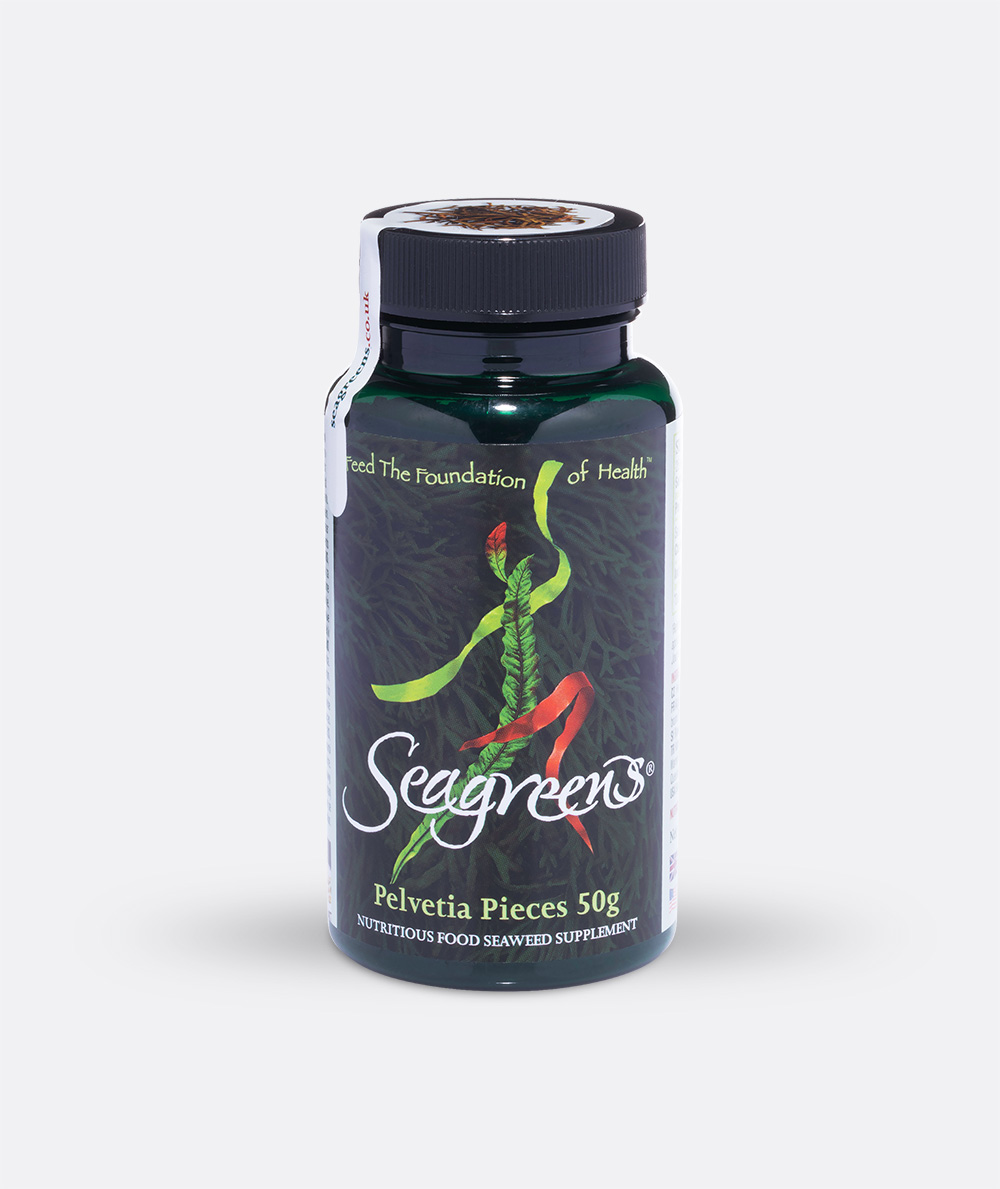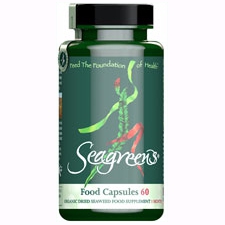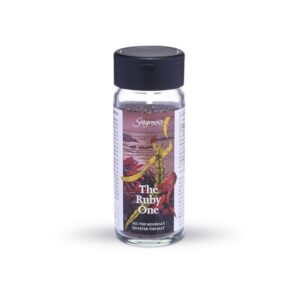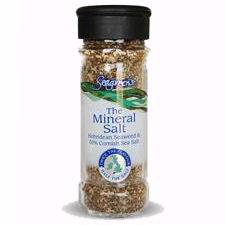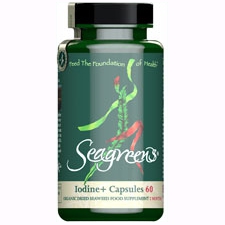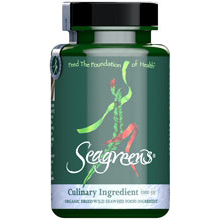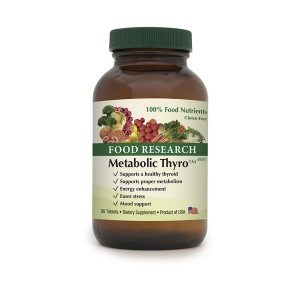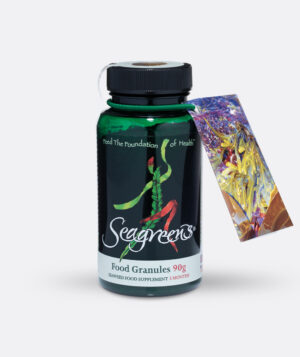Description
A unique multi-purpose food. These dried pieces of Seagreens wild Pelvetia Canaliculata can be milled in a table grinder or soaked in cold water for use in salads or warm vegetables, or simply chewed. They complement herbs and spices and are an ideal mineral-balanced alternative to table salt. Try mixing with unrefined salt, herbs and spices adding a nutritious taste of the wild to many different foods. Wild organic seaweed collected in crystal clear Arctic waters for cooking and seasoning” – Harper’s Bazaar.
Pelvetia Pieces per 2 grams
(approximately 0.07oz or a heaped teaspoon)
Such a comprehensive balance of nutrients is found in no other natural food but seaweed. From the primordial ocean to the vegetation and animals which remain our food today, our own bodily composition has its origins in the earliest organisms and the chemistry of life itself. As life forms became increasingly diverse, they adapted to more specific diets. To survive on a narrower range of nutrients and protect themselves against toxicity, each evolved different mechanisms of selectivity and defence. That is why we need a wide variety of land based foods, since each has a little of what we need. But nutrient loss in agricultural soils and manufactured and denatured food makes nutritional balance, especially of all the micronutrients, harder to achieve. Almost as old as the ocean, seaweed is an outstanding whole food which complements and fills the gaps in all land food and special diets.
1g (gram) = 1000mg (milligram) = 1,000,000µg (microgram)
Amino acids
Alanine 2.85 mg, Arginine 1.36 mg, Asparagine 1 mg, Aspartic acid 6.07 mg, Cystine and Cysteine* 0.2 mg, Cystathionine 1 mg, Glutamic acid 5.77 mg, Glutamine 1 mg, Glycine 2.64 mg, Histidine 0.74 mg, Homocysteine 1 mg, Hydroxyproline 1 mg, Isoleucine 1.88 mg, Leucine 3.31 mg, Lysine 2.4 mg, Methionine 0.24 mg, 1-Methylhistidine 1 mg, 3-Methylhistidine 1 mg, Ornithine 1 mg, Phenylalanine 2.76 mg, Phosphoserene 1 mg, Proline 0.41 mg, Sarcosine 1 mg, Serine 2.43 mg, Taurine 1 mg, Threonine 2.75 mg, Tryptophan 0.14 mg, Tyrosine 2.09 mg, Valine 2.5 mg.
*Cysteine is a non-essential methionine amino acid derivative formed in collaboration with vitamins B6 and B12 whereas cystine, a compound formed when two amino acids form a disulfide bond, is a more stable semi-essential amino acid. Both are important in protein synthesis, detoxification and metabolism and cystine is a substrate for the cystine-glutamate cell transport by which it is readily broken down to cysteine in the cell. Normal human hair and skin contains 10-14% cystine.
Amino acids are…
Simple organic compounds containing both a carboxyl and an amino group which can combine in linear arrays to form proteins in living organisms. There are several important amino acids which have no relation to protein, such as the neurotransmitter aminobutyric acid and betaines. There are 20 common amino acids all of which are present in Seagreens®, which is not the case in any other whole food. The simplest amino acid is glycine, a major inhibitory neurotransmitter in the spinal cord and brainstem of the vertebrate central nervous system.
Antioxidant capacity – principal antioxidant nutrients
Alpha-linolenic acid (ALA) 5392 µg, Calcium 25,800 µg, Copper 2.05 µg, Magnesium 16,290 µg, Manganese (part of the antioxidant enzyme Superoxide dismutase) 265 µg, Polyphenols gallic acid equivalent) 25,423 µg, Polyphenols (tannins) 37,800 µg, Potassium 42,900 µg, Selenium 0.33 µg, Superoxide dismutase 159 units, Vitamin A (carotenoids) 23.2 µg, Vitamin C 110.28, Vitamin E (alpha-tocopherol) 290 µg, Zinc 44.54 µg.
Antioxidants are…
Nutrients widely present in body fluids and tissues that inhibit or remove potentially damaging products of oxidation or oxidizing agents in a living organism. Water-soluble antioxidants are effective in cells and blood plasma while lipid-soluble antioxidants protect cell membranes from lipid peroxidation. In the presence of sufficient nutrients both can be synthesized in the body or obtained from the diet. Antioxidant capacity of Seagreens® wrack seaweeds is higher than in commonly consumed fruit and vegetables, including green tea which has a similar polyphenol content by weight. Seagreens® antioxidants have been shown to inhibit and therefore prolong carbohydrate and lipid digestion with the potential to favourably influence insulin response and the glycemic index of food. They may be effective against reactive oxygen species (ROS) in the lower intestine. See also Polyphenols.
Betaines
Glycine Betaine trace, Gamma Amino Butyric Acid Betaine trace, Delta Amino Valeric Acid Betaine trace, TML (Laminine) trace, L-Carnitine trace, Trigonelline trace.
Betaines are…
Compound derivatives of glycine (an amino acid) characterised by high solubility in water which functions as an osmotic agent in plant tissue. 6 betaines have so far been identified in Seagreens®. See also Amino acids.
Carbohydrates
1,115 mg of which total dietary fibre is 936.40 mg including non-starch polysaccharides Algin, Fucose, Fucoidan, Mannitol, Methylpentosans, Laminarin, Mannuronic acid and Chlorophyll. Soluble fibre is approximately 20% of total dietary fibre, insoluble 80%.
Carbohydrates are…
Organic compounds occurring in foods and living tissues including sugars, starch and cellulose, containing 2 parts hydrogen to 1 part oxygen, the same ratio as water, which can typically be broken down to release energy more readily than proteins or fats. Simple carbohydrates are sweet-tasting sugars which can be absorbed through the intestine into the bloodstream as monosaccharides (glucose, fructose and galactose) and disaccharides (lactose, sucrose and maltose) can be converted to their two monosaccharide bases in the digestive tract. Complex carbohydrates, on the other hand, are commonly known as starches made up of chains of glucose molecules. Typical high starch foods include most grains (wheat, corn, oats and rice) and potatoes. Starch is also broken down in the digestive tract though more slowly than simple carbohydrate. Compared with most vegetables Seagreens® has a valuable ratio of soluble to insoluble fibre, with soluble fibre up to 20% of total dietary fibre. The wide variety of non-starch polysaccharides is also antioxidant, contributing to Seagreens® outstanding antioxidant capacity. Polysaccharides are the most abundant carbohydrates found in food which perform a wide range of functions from storing energy and cellular messaging to endothelial tissue support and protection. They help maintain the immune system and cardiovascuar health and regulate blood pressure and blood sugar levels.
Enzymes
Carbohydrase 12 units, Protease 629 units, Superoxide dismutase 159 units, Uronic acid 47 units.
Enzymes are…
Biological molecules that catalyse (i.e., increase the rates of) chemical reactions. Important in digestion, enzymes such as amylases and proteases break down large molecules (starch or proteins, respectively) into smaller ones, so they can be absorbed in the intestines. Starch molecules are too large to be absorbed from the intestine, but enzymes hydrolyze the starch chains into smaller molecules such as maltose and eventually glucose, which can then be absorbed. Other nutrients in Seagreens® have beneficial effects on certain digestive enzymes resulting in prolonged carbohydrate digestion and the steadier release of sugars.
Essential fatty acids
Alpha amino-n-butyric acid 10 µg, Alpha-linolenic acid (ALA) (antioxidant) 5,392 µg, Beta aminoisobutyric acid 10 µg, Docosadienoic acid 4 µg, Docosapentaenoic (DPA) 40 µg, Docosahexaenoic acid (DHA) 40 µg, Eicosapentenoic acid (EPA) 5,396.4 µg, EPA and DHA Omega-3 5,436.4 µg, Gamma amino-n-butyric acid 10 µg, Oleic acid 4 µg, Omega-3 13,758 µg, Omega-6 41,360 µg*, Omega 9 55,666 µg, Monounsaturated fatty acids 46,400 µg, Polyunsaturated fatty acids 38,200 µg, Saturated fatty acids 22,300 µg, Trans fatty acids (mono- and poly-unsaturates) 0.4 µg. *Omega 3:6 ratio 33%.
Essential fatty acids are…
EFAs including important-to-the-brain PUFAs (polyunsaturated fatty acids) are fatty acids that humans must obtain from food because the body cannot synthesize them. The term “essential” refers to fatty acids required for many neural and other biological processes, not those that solely act as fuel. Seagreens® Pelvetia seaweed (Channeled Wrack) is particularly rich in essential fatty acids and one reason for its inclusion in Seagreens® Food Capsules and Food Granules blends.
Minerals
Calcium (antioxidant) 25.8 mg, Magnesium (antioxidant) 16.3 mg, Nitrogen 15.2 mg, Phosphorus 11.93 mg, Potassium (antioxidant) 42.9 mg, Sodium 59.6 mg, Sulphur 81.3 mg.
Minerals are…
Solid and soluble naturally occurring substances available in edible form ranging from so-called rare earths in the form of clays, to various sands and salts, animal tissue (flesh and bones) and plants which absorb them from the soil and the ocean as ‘colloidal’ (able to be bound) minerals which is the soluble form in which they present in Seagreens® seaweeds. Colloidal minerals are never intrinsically toxic. Seagreens® provide a natural balance of all the minerals and trace elements known to be present or needed in the human body. This is of special value because it is otherwise “necessary that we consume some 20 different vegetables in the proper proportions, and that these vegetables have been grown in soil that is sufficiently rich in nutrients and free from the many different chemical products now in common use” (Muller, Colloidal Minerals and Trace Elements, 2002). Colloidal minerals and trace elements of sea or plant origin can be 98% assimilated. Their absorption is 2.5 times greater than that of chelated minerals and 10 times greater than that of non-organic minerals. 7,000 times smaller than red blood cells, colloidal minerals are readily absorbed because they contain a negative charge, while the intestinal wall holds a positive charge, creating a chemical gradient which concentrates colloidal minerals towards the intestinal mucous and enables their absorption. A chelated mineral is bound or held by amino acid molecules which naturally encircle mineral atoms. Isolated metallic atoms do not naturally exist in the body. In Seagreens®, with its ample amino acid component, minerals are bound to protein ions in the most effective form of chelation which comes closest to achieving a neutral pH, which assists their absorption. Minerals help regulate the body’s elimination system and regenerate the blood at a molecular level. Mineral deficiency and imbalance thus puts us at risk of chronic toxicity, endemic in modern societies. Arsenic, for example, is essential for the survival of newborns. Dietary arsenic was eliminated in laboratory tests in rats with the result that their growth rate slowed, they lost their fur, seldom moved and their red blood cells became inactive. When colloidal arsenic was introduced these effects were reversed. In all cases the amount of the element significantly alters its physiological effect. In an ionised form, calcium has coagulant properties, so that a large dose will restore calcium to bone or tissue, whilst very small amounts in colloidal form endows it with regulating properties. All trace elements can be toxic if taken in excess and some, such as aluminium, cadmium, mercury and arsenic are toxic at very low levels and may occur as environmental pollutants. Where they exist in Seagreens® they do so below tolerable levels and due in part to its high content of colloidal minerals, Seagreens® is also a natural binding or chelating agent assisting in the elimination of such potentially toxic heavy metals and other toxic substances. Seagreens® can potentially restore to the body the most primal natural marine balance of minerals and trace elements still available. Like seawater which has a pH between 7.9 and 8.3, Seagreens® are the most alkalising of all foods. It should not be surprising that its simple addition to the daily diet can so dramatically regulate both an overly acidic gastric and intestinal environment and an overly alkaline cellular environment and in addition ameliorate the causes of all kinds of disorders and diseases. Due to its electrolytic composition, in nutrition “seawater fundamentally modifies the mineral content of different tissues by correcting ionic imbalances, which explains the effect it has on allergic diseases. In clinical settings the subjective and objective results were so favourable that it gave the impression of a specific curative effect” (Bensch, Therapeutic Properties of Seawater, Journal of Medicine, 1966).
Polyphenols
25,423 µg (gallic acid equivalent).
Polyphenols are…
Nutrients composed of four main classes – phenolic acids, flavonoids, stilbenes and lignans – principally found in fruits, berries, seeds, cereals and vegetables including onions, cocoa and tea. Lignans are derived from the amino acid phenylalanine. Polyphenols also include phenols and tannins. They are secondary metabolites of plants or the bacteria and fungi associated with them, which help protect the plant against aggressive pathogens and radiation. The sometimes confusing term ‘phenolic’ refers to phenol compounds within a larger class of organic ‘polyphenol’ compounds and all typically have valuable antioxidant properties which counter cellular damage and oxidative stress from free radicals (waste or by-products) arising from pollution, smoking and eating rancid or inflammatory foods as well as from the body’s normal metabolic processes. Tannins are particular polyphenolic compounds, found particularly in wines, tea, cocoa and many other plants, consisting of gallic acid derivatives, which bind to and precipitate proteins and are strongly antioxidant. Polyphenols are widely indicated in the prevention of human degenerative diseases and are anti-carcinogenic. The level of polyphenols in Seagreens® is directly relasted to its high antioxidant capacity – see also Antioxidant capacity above.
Protein
100.5 mg.
Proteins are…
Complex organic compounds of high molecular weight, essentially composed of at least 20 different amino acids in peptide linkages containing nitrogen, carbon, hydrogen, oxygen and usually sulphur, ubiquitous in plants and animals as the principal constituents of cell protoplasm. Each protein has a unique, genetically defined amino acid sequence which determines its structure and function. Proteins serve in oxygen transport, muscle contraction, electron transport and other activities, especially as structural components of body tissues such as muscle tissue, hair, collagen, and as enzymes, hormones, immunoglobulins and antibodies. Seagreens® is a source of high quality vegetable protein, containing the full balance of amino acids, of particular use for vegetarians and vegans because most other plant proteins are low in one or other essential amino acids. For instance, grains tend to be short of lysine whilst pulses are short of methionine. This does not mean that vegetarians or vegans need go short on essential amino acids. Combining plant proteins, such as a grain with a pulse, leads to a high quality protein which is just as good, and in some cases better, than more plentiful protein from animal foods. The limiting amino acid tends to be different in different proteins, so when two different foods are combined, the amino acids in one protein can compensate for the one lacking in the other. This is known as protein complementing. Vegetarians and vegans eating a well-balanced diet based on grains, pulses, seeds, nuts and land and especially sea vegetables will be consuming a mixture of proteins that complement one another naturally. Beans on toast, cheese or a peanut butter sandwich, muesli with milk (soya or cow’s) and rice with peas or beans, are all common examples of protein-complementing Seagreens® products could be included in any one of them. The body retains a short-term store of essential amino acids so as long as deficiencies are replenished within a day or two, a well-balanced vegetarian or vegan diet can supply all the protein we need.
Sugars
Fructose trace, Galactose trace, Glucose trace, Maltose trace, Sucrose trace.
Sugars are…
Simple monosaccharides like fructose, glucose and galactose, and compound disaccharides like maltose and sucrose, are closely related and found in the tissues of most plants. Lactose which is found in cow’s milk, is formed by the combination of a molecule of galactose with one of glucose and broken down in human digestion by the enzyme lactase which is present in some seaweeds. Some people are deficient in this enzyme and cannot digest lactose. The digestion of sugars releases energy into the bloodstream. Seagreens® have unique polysaccharides, some of which have been shown to have beneficial effects in digestion, in that they inhibit carbohydrate digesting enzymes which slows and prolongs the release of sugars of special interest in sports and diabetes.
Trace elements
Antimony 0.78 µg, Barium 23.46 µg, Beryllium trace, Bismuth trace, Boron 210.11 µg, Bromine 707.6 µg, Cerium 1.7 µg, Caesium 0.05 µg, Chromium 0.88 µg, Cobalt 0.58 µg, Copper 2.05 µg, Dysprosium 0.09 µg, Erbium 0.5 µg, Europium 28 µg, Flouride (acid soluble) 7 µg, Gadolinium 0.12 µg, Gallium 0.14 µg, Germanium 0.14 µg, Gold 0.07 µg, Hafnium trace, Holmium 0.02 µg, Iodine 548 µg*, Iridium trace, Iron 1,182.5 µg, Lanthanum 0.84 µg, Lithium 1.58 µg, Lutetium 0.007 µg, Manganese 265.2 µg, Molybdenum 1.52 µg, Neodymium 0.68 µg, Nickel 4.06 µg, Niobium 0.02 µg, Osmium trace, Palladium 0.05 µg, Platinum 1.01 µg, Praeseodymium 0.18 µg, Rhenium 0.09 µg, Rubidium 15.74 µg, Ruthenium 0.01 µg, Samarium 0.13 µg, Scandium 0.2 µg, Selenium 0.33 µg, Silicon** 590 µg, Silver 0.13 µg, Strontium 1600 µg, Tantalum trace, Tellurium 0.1 µg, Terbium 0.02 µg, Thallium 0.02 µg, Thorium 0.03 µg, Thuliam 0.34 µg, Tin 0.04 µg, Titanium 0.16 µg, Tungsten trace, Uranium 0.61 µg, Vanadium 4.82 µg, Ytterbium 0.05 µg, Yttrium 0.64 µg, Zinc 44.54 µg, Zirconium 0.47 µg .
*For more iodine information and a comparison of iodine levels in Seagreens products see below ‘Iodine levels in Seagreens® nutrition products’.
**Silicon and silica are different chemical species, the key difference being that silicon is an element whereas silica is a compound. Higher levels in seaweed may indicate the coincidental collection of sand during harvesting and is indicative of low grade seaweed unlikely to have been produced to standards for human consumption.
Trace elements are…
Trace elements (or trace minerals) are metalloids or metallic elements which represent only the smallest part of a living organism (less than 1mg per litre of internal fluid) yet are essential in its growth, equilibrium and regulatory processes. Quantity is less important than quality and in natural sources the trace elements exist in ideally balanced proportions and forms which allow the body to recognise and ultilise them. A single trace element may have different roles in numerous biochemical processes in the body. More than 67 have been found in Seagreens® seaweed species, the 58 presented here being regularly monitored. Seagreens continues to work towards the widest possible field of analysis. Like other minerals, trace elements are solid and soluble naturally occurring substances available in edible form ranging from the rare earths in the form of clays, to various sands and salts, animal tissue (flesh and bones) and plants which absorb them from the soil as ‘colloidal’ minerals (in a soluble suspended state). Colloidal minerals are never toxic and this is the soluble form in which they present in Seagreens® seaweeds. The human body and Seagreens® contain all the elements of the Periodic Table that are available to it in its environment. Seagreens® provide a natural balance of all the minerals and trace elements known to be present in the human body in colloidal form. It is otherwise “necessary that we consume some 20 different vegetables in the proper proportions, and that these vegetables have been grown in soil that is sufficiently rich in nutrients and free from the many different chemical products now in common use” (Muller, Colloidal Minerals and Trace Elements, 2002). Colloidal minerals and trace elements of sea or plant origin can be 98% assimilated. Their absorption is 2.5 times greater than that of chelated minerals and 10 times greater than that of non-organic minerals. 7,000 times smaller than red blood cells, colloidal minerals are readily absorbed because they contain a negative charge, while the intestinal wall holds a positive charge, creating a chemical gradient which concentrates colloidal minerals towards the intestinal mucous and enables their absorption. A chelated mineral is bound or held by amino acid molecules which naturally encircle mineral atoms. Isolated metallic atoms do not naturally exist in the body. In Seagreens®, with its ample amino acid component, minerals are bound to protein ions in the most effective form of chelation which comes closest to achieving a neutral pH, which assists their absorption. Minerals help regulate the body’s elimination system and regenerate the blood at a molecular level. Mineral deficiency and imbalance thus puts us at risk of chronic toxicity, endemic in modern societies. Organic arsenic, for example, is essential for the survival of newborns. Dietary arsenic was eliminated in laboratory tests in rats with the result that their growth rate slowed, they lost their fur, they seldom moved and their red blood cells became inactive. When colloidal arsenic was introduced these effects were reversed. In all cases the amount of the element significantly alters its physiological effect. In an ionised form, calcium has coagulant properties, so that a large dose will restore calcium to bone or tissue, whilst very small amounts in colloidal form endows it with regulating properties. All trace elements can be toxic if taken in excess and some, such as aluminium, cadmium, mercury and arsenic are toxic at very low levels and may occur as environmental pollutants. Where they exist in Seagreens® they do so below tolerable levels and due in part to its high content of colloidal minerals, Seagreens® is also a natural binding or chelating agent assisting in the elimination of such potentially toxic heavy metals and other toxic substances. Seagreens® can potentially restore to the body the most primal natural marine balance of minerals and trace elements still available. Like seawater which has a pH between 7.9 and 8.3, Seagreens® are the most alkalising of all foods. It should not be surprising that its simple addition to the daily diet can so dramatically regulate both an overly acidic gastric and intestinal environment and an overly alkaline cellular environment and in addition ameliorate the causes of all kinds of disorders and diseases. Due to its electrolytic composition, in nutrition “seawater fundamentally modifies the mineral content of different tissues by correcting ionic imbalances, which explains the effect it has on allergic diseases. In clinical settings the subjective and objective results were so favourable that it gave the impression of a specific curative effect” (Bensch, Therapeutic Properties of Seawater, Journal of Medicine, 1966).
Vitamins
A (carotenoids) 23.2 µg, B1 (thiamin) 1.14, B2 (riboflavin) 0.58, B3 (niacin or vitamin PP) 134.8 µg, B5 (pantothenic acid and calcium pantothenate) 0.01 µg, B6 (pyridoxine) 0.02, B9 (folate) 1.43 µg, B12 (cobalamin) trace, C 110.28 µg, D2 (ergocalciferol) trace, D3 (cholecalciferol) trace, E (alpha-tocopherol) with all the isomers of wheat germ 290 µg, H (biotin or vitamin B8) 204 µg, K (K3 phytomenadione, K1 phylloquinone, K2 menaquinone 4 and menaquinone 7) 3.28 µg.
Vitamins are…
Organic fat-soluble or water-soluble substances that are required in small amounts, necessary for numerous special functions and affected by environmental conditions such as light, heat and air. Food storage, processing and cooking can all reduce the level of vitamins in food. The fat-soluble vitamins are A, D, E and K which can be stored in the body and so dietary sources are not needed every day. The water-soluble vitamins are C and the B group which includes B1, B2, B3, B6, B12, folic acid, biotin and pantothenic acid. The body is less able to store water-soluble vitamins, with the exception of vitamin B12 which is stored in the liver, and so they are needed daily and are more easily lost during cooking. Vitamin A, C, D2, D3 and E are also antioxidants. Seagreens® contain an unusually comprehensive balance of small but significant amounts of all these vitamins.
Nutritional values (typical) per 100 g
Energy 191 kc / 782 kj
Protein 5.03 g
Carbohydrate (total) 55.73 g
of which
Carbohydrate (available) 8.91 g
Sugars <0.65 g
Fat 4.6 g
of which
Saturates 1.05 g
Mono-unsaturates (cis) 2.83 g
Mono-unsaturates (trans) <0.01 g
Polyunsaturates 0.96 g
Polyunsaturates (trans) <0.01 g
Dietary fibre (AOAC) 46.82 g
of which
Insoluble fibre 39.17 g
Soluble fibre 7.06 g
Sodium 2.98 g
Moisture 13 g
Ingredients: 100% Organic wild seaweed from Scotland. Large cut pieces of Seagreens arctic fresh pelvetia seaweed
Each bottle contains 50 grams.

